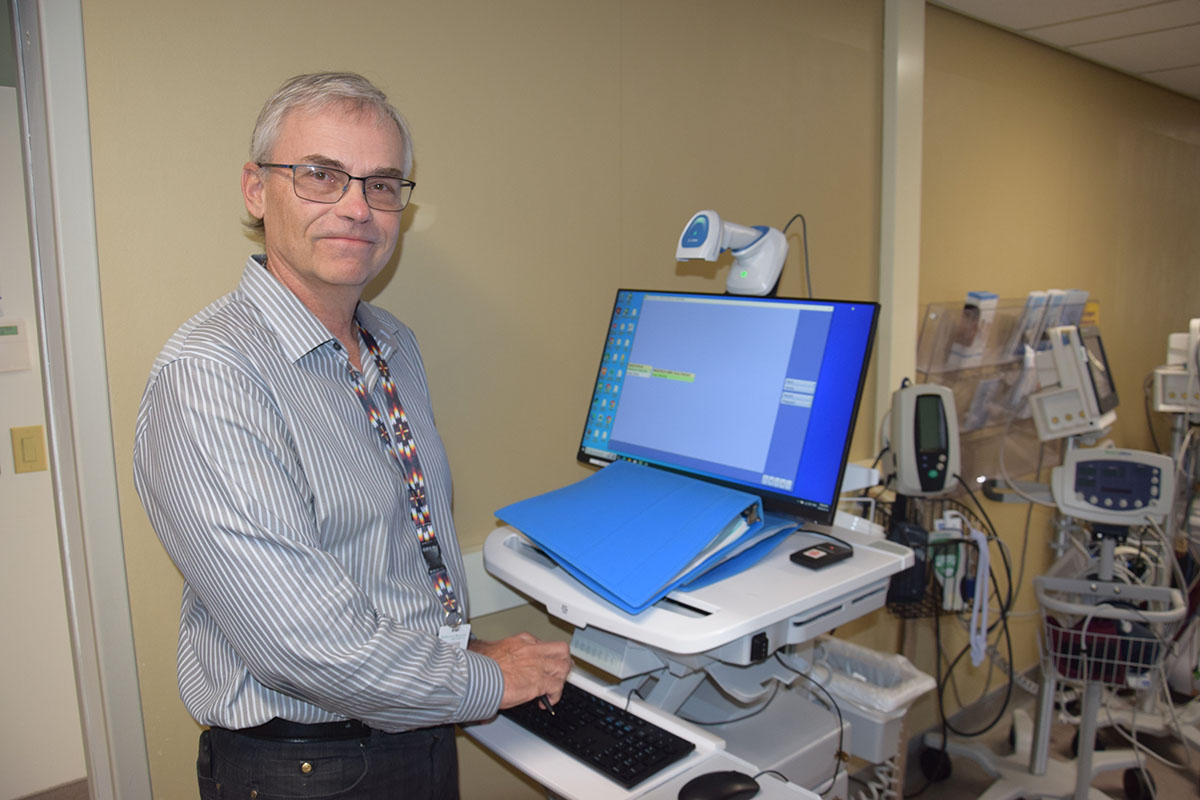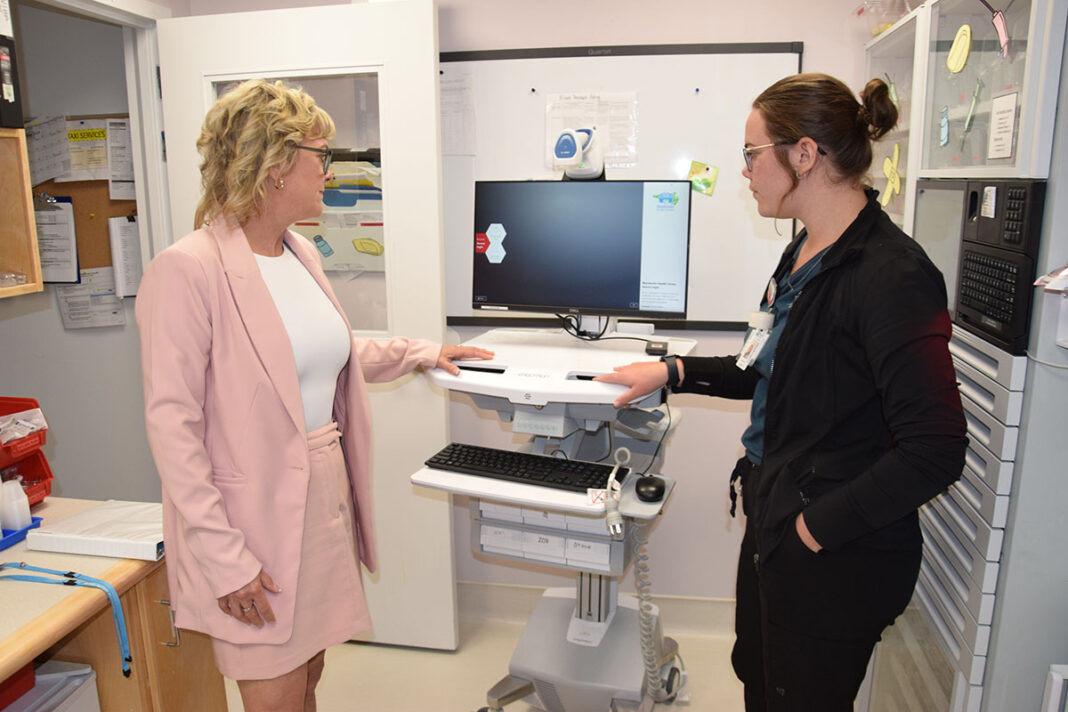MANITOULIN—There is more than a hint of anticipation in the air as the administration and staff of the Manitoulin Health Centre (MHC) prepares to launch ONE HIS, a new web-based health information system on June 4 that will revolutionize e-health records and patient care. MHC is joining 23 other hospitals across the Northeast in launching the “second wave” of an integrated system that will ensure medical history information for patients can be accessed by hospitals seamlessly and provide better control over medication dispensing.
MHC CEO Paula Fields explained that the new system is enabled by MEDITECH Expanse, an award-winning system that includes “advanced clinical functionality including computerized provider order entry, barcode medication verification and electronic clinical documentation.”
“Having a single, connected electronic health information system (the ‘HIS’ in ONE HIS) supporting a single patient record across all of Northeastern Ontario offers significant clinical and patient benefits,” said Ms. Fields. This assessment is based on the results that have been observed in other jurisdictions that were in the first wave and initial second wave launches.
“Patients will not have to remember and repeat their health history to multiple providers because their health records will be available wherever they go for hospital care across the Northeast,” she said. “Having a single, unified patient record will also result in faster and more accurate treatment decisions because clinicians will have complete and up-to-date information.”
The new system will replace the plethora of hand-written and other jotted notes that typically make up a health professional’s record of medications and treatments for their patient.
Among the benefits of the new system it is anticipated it will ensure a “significant reduction in the number of times patients are sent for the same tests by multiple providers because the latest results will be on the patient’s chart.”
“This will provide increased opportunities to enhance patient safety, deliver better outcomes and reduce harm through accurate records, computerized provider order entry and bedside barcode verification,” noted Ms. Fields, who took The Expositor on a short tour of the new system.
A cart containing the medications for the patients in the hospital is preloaded by the hospital pharmacy and locked with a finger swipe across a sensor by the attending nurse. Utilizing barcodes and a multiple verification system, the proper medications authorized for each patient appears in a drawer following verification. (The Expositor tried the fingerprint swiping sensor to no avail.)
“Not even my finger will open the system,” noted Ms. Fields, who although herself a nurse, has not been entered into the system. On a side note, the introduction of the ONE HIS system will see Ms. Fields and other health professionals in administration donning their nurses’ attire and lending a hand to help with anticipated delays while the system is being launched. It will be literally all hands on deck.

The closed loop medication system will prevent medication errors by replacing manual steps with automated electronic ones. For example, once the physician’s order has been reviewed by the pharmacy, the medications flow to the automatic dispensing unit, where the nurses sign in electronically and receive information on the timing and administration of the dose.
A barcode on the patient’s wrist band acts as a double check to ensure that timing, medication and dose are all correct.
The computerized physician order entry, medications, laboratory and radiology orders will all now take place through a computer application, rather than paper, fax or telephone. It wasn’t said outright, but the system will ensure that doctor’s legendary scrawls will no longer present a challenge to nurses and other professionals to decipher.
One of the beauties of the new system is that doctors will be also able to update and modify treatment regimes on the fly, responding to notes from the attending nurses on a patient’s status and response to treatment and medications—and they will be able to do so remotely.
The system includes built-in clinical support tools that can automatically check for drug interactions, medication allergies and other potential issues.
The result will be improved efficiency and time savings, as providers will submit orders electronically to ensure that orders arrive at pharmacies, laboratories and radiology facilities faster.
Clinical documentation will no longer be a hybrid system of handwritten notes and computer entries—all will be input into the system. “Creating a concise record of care for the patient’s visit that can be viewed during subsequent visits to MHC, by their primary care givers, and if necessary, when they visit other centres such as Health Sciences North.”
A huge change in documentation will take place in the emergency department, which is currently all paper-based. Triage, the preliminary assessment of treatment urgency and nature of treatment required and there might be some delays inherent in adapting to the change despite several months of preparation for the switchover.
“We ask for the public’s consideration and patience with our team as we learn to navigate the new system,” said Ms. Fields. “We will be providing additional ‘at elbow’ support for weeks following the ‘go live’ on June 4. Patients may experience longer wait times and be asked for the personal health information as we build the system.”
Island health care professionals have agreed to increase the number of primary care and home visits in order to help reduce the number of “low acuity” visits to the hospital.
This coming fall, the hospital will be embarking on an ambitious plan to replace its infusion pumps with those that can connect to the system. “Smart pumps will add additional safeguards and patient treatment information that will flow to the comprehensive patient record,” said Ms. Fields. So, keep an eye out for that fundraising campaign. Capital expenses are not funded by the government and each pump costs $5,000, and the accompanying software a further $60,000—MHC requires 25 such pumps to provide intravenous therapy at both sites.





